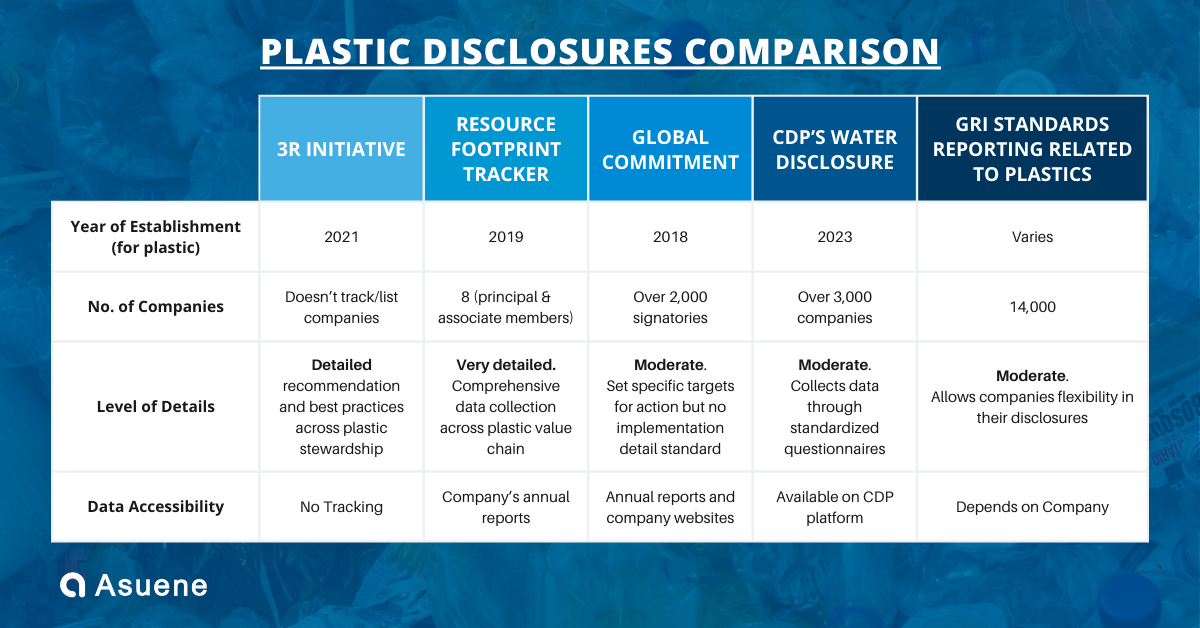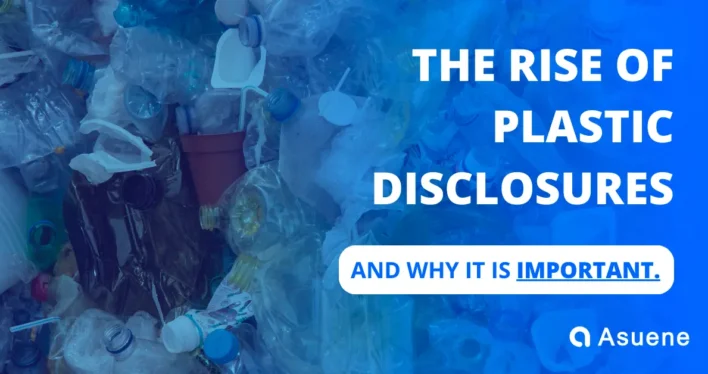Plastic, once treated as a wonder material, now becomes the source of pressing environmental issues globally. Its production has skyrocketed from a mere 2 million tonnes in 1950 to a staggering 450 million (Our World in Data, 2019). This plastic tide engulfs our land and oceans, posing a grave danger to wildlife and ecosystems. Recognizing the urgency, the UN is leading the charge towards a landmark global plastic treaty in 2024, aimed to curb plastic production and pollution. By shedding light on their plastic footprint, these disclosures offer a crucial pathway to transparency, accountability, and ultimately, a more sustainable future for the planet. This article will explore existing frameworks, providing clarity and guidance to navigate this evolving landscape of plastic disclosures. Discover how transparency unlocks valuable insights and propels businesses to reduce their environmental impact, and contribute to a plastic-free future.
Photo by
WBCSD: Mapping Plastic Transparency
In 2022, the World Business Council for Sustainable Development (WBCSD) published a white paper titled “Enabling Corporate Plastics Disclosure“. This document analyzes existing plastic disclosure frameworks and identifies key metrics that effectively communicate the environmental impact of plastic pollution. These metrics are intended to support the development of a standardized global accountability framework, aligning with the objectives of the UN Plastic Treaty. Here are a few of the plastic-focused disclosure frameworks mentioned by WBCSD.
Global Commitment (2018)
Launched in October 2018 by the Ellen MacArthur Foundation and the UN Environment Programme, the New Plastics Economy Global Commitment unites businesses, governments, and other organizations to achieve a circular economy for plastic. Signatories commit to measurable targets related to plastic packaging, including reduction, recycled content, and the use of reusable, recyclable, and compostable materials. A standardized reporting framework ensures transparency and consistency in data sharing across participants. The scope of the Global Commitment is mostly focused on packaging only: single-use plastic packaging without including durables and microplastics.
ReSource Footprint Tracker (2019)
ReSource: Plastic, a WWF initiative, partners with companies committed to transforming plastic pledges into measurable action. It offers an innovative framework that guides companies to align their efforts with a three-pronged approach to systemic change. This includes tracking and reporting progress against commitments, and estimating plastic recycling, incineration, landfill, and mismanagement rates. The ReSource tracker provides a standardized methodology for companies to assess their plastic footprints and publicly report on progress toward their plastic waste commitments. Since 2021, a web-based version allows users to input data, receive calculated waste management model results, and visualize progress on an interactive dashboard. The scope of ReSource primarily focuses on the plastic packaging located within the United States.
3R Initiative Guidelines for Corporate Plastic Stewardship (2021)
The 3R Initiative establishes a comprehensive framework encompassing standardized accounting and reporting on plastic footprints, mitigation strategies, and commitments to waste reduction and circularity. It promotes deeper integration of plastic footprint measurements within the “measure, reduce, communicate” stewardship approach. Specifically, the guidelines provide:
- High-level metrics for plastic footprint assessment
- A mitigation hierarchy prioritizing strategies for reducing footprint and leakage
- Guidance on using plastic credits responsibly within a stewardship program
- Three key leadership commitments with clear pathways to achievement
The scope of 3R Initiative encompasses the entire plastic value chain: product, packaging, operations, and supply chain across upstream, operational, and downstream activities.
Beyond Dedicated Disclosures
Other than the dedicated plastic disclosures mentioned above, common environmental reporting frameworks also require companies to disclose relevant plastic use and impacts. Some examples include:
CDP’s Plastic Reporting in Water Security Disclosure (2023)
Since 2023, CDP has integrated a new Plastics Module into its Water Security questionnaire. This module targets companies across the entire plastic value chain (use, production, and sales) to gather comprehensive data on the impact of plastic on water resources. This includes water extraction, pollution, and microplastic release. While the data collected through this module is not currently part of CDP’s scoring system, it is shared with investors and stakeholders. This transparency initiative aims to incentivize companies to develop strategies for sustainable plastic use and mitigate plastic’s burden on water resources.
GRI Standards Reporting Related with Plastics
Although the Global Reporting Initiative (GRI) lacks a dedicated plastic standard, several existing frameworks capture relevant information:
- GRI 301: Materials 2016 | Scope : Plastic use, recycled content, and plastic waste generated.
- GRI 303: Water and Effluents 2018 | Scope : Microplastic release and wastewater treatment related to plastic.
- GRI 306: Waste 2020 | Scope: Plastic waste generation, management, and disposal methods.

Plastic Disclosure: Key to the Future
As governments worldwide tighten plastic regulations (e.g., EU’s microplastics fee for beauty companies), and the UN Plastic Treaty looms in the near future, businesses must step up their plastic circulation game. Proactive preparation is essential, and rethinking plastic use and embracing robust plastic disclosures are key steps. Disclosures offer indispensable tools for demonstrating transparency and aligning with evolving regulations, ultimately positioning companies for success in a future with less plastic and more accountability.



